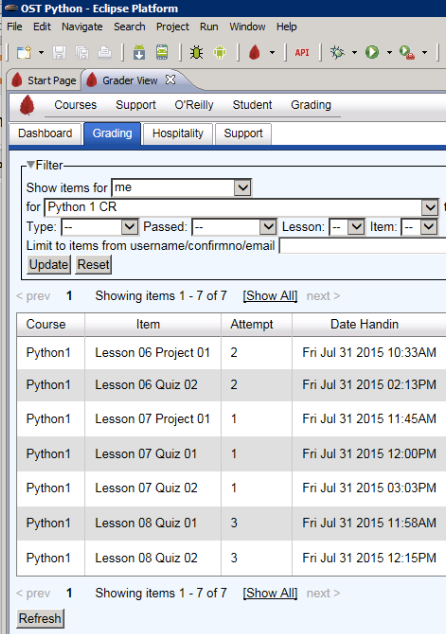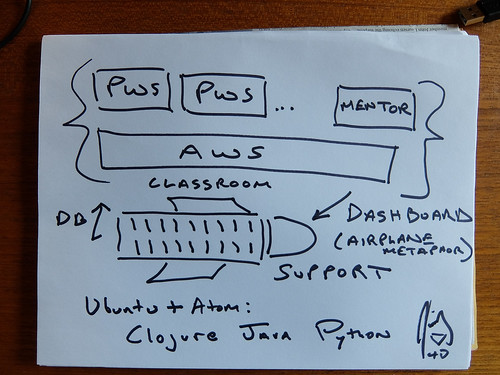Setting up a PWS in the form of a remote desktop on AWS is not that crazy-making, per this Youtube demo.
Your school may want to provision these setups to students automatically, with lots of stuff pre-installed besides bare Ubuntu. I-Python Notebooks + VPython, for example, for 2D and 3D computer graphics, lots of user activity.
Core to any school is the workflow around sending work round trip to / from a mentor: your school, like ours, may already have solutions for how to accomplish that.
Typically, a mentor would expect a task queue for notifications of submitted student work (in order received or in some other mentor-selected order). The mentor opens a copy of a student project and runs it, then provides feedback. Quizzes may be dealt with much the same way.
Our school uses iterative feedback and multiple attempts in lieu of grades. Why settle for a B- when, with more practice, your work could be perfect?
Some students take more time to get through the obstacle course than others. With a self paced learning model, that's perfectly OK.
Tasks per course are marked not started, complete or still in progress, with "percent complete" (tasks per course) part of the student dashboard as well.
Our school has not used AWS to host student remote desktops. The cloud was not that sophisticated when our blueprints were drawn up in Traction Station, Champaign-Urbana many years ago.
We went with Windows servers back ended into a Linux file store and a bash shell accessible through Terminal in Eclipse (our choice of IDE), but the idea is similar. Java, Python, C++, Android... all learned in the same development environment.
Choice of IDE is sometimes critical. Emacs? IntelliJ? Atom?
A Clojure plug-in for Atom is under active development. However feedback from the Clojure list suggests Eclipse or Emacs might be better.
Your school may want to provision these setups to students automatically, with lots of stuff pre-installed besides bare Ubuntu. I-Python Notebooks + VPython, for example, for 2D and 3D computer graphics, lots of user activity.
Core to any school is the workflow around sending work round trip to / from a mentor: your school, like ours, may already have solutions for how to accomplish that.
Typically, a mentor would expect a task queue for notifications of submitted student work (in order received or in some other mentor-selected order). The mentor opens a copy of a student project and runs it, then provides feedback. Quizzes may be dealt with much the same way.
Our school uses iterative feedback and multiple attempts in lieu of grades. Why settle for a B- when, with more practice, your work could be perfect?
Some students take more time to get through the obstacle course than others. With a self paced learning model, that's perfectly OK.
:: mentor dashboard (ost) ::
Tasks per course are marked not started, complete or still in progress, with "percent complete" (tasks per course) part of the student dashboard as well.
Our school has not used AWS to host student remote desktops. The cloud was not that sophisticated when our blueprints were drawn up in Traction Station, Champaign-Urbana many years ago.
We went with Windows servers back ended into a Linux file store and a bash shell accessible through Terminal in Eclipse (our choice of IDE), but the idea is similar. Java, Python, C++, Android... all learned in the same development environment.
Choice of IDE is sometimes critical. Emacs? IntelliJ? Atom?
A Clojure plug-in for Atom is under active development. However feedback from the Clojure list suggests Eclipse or Emacs might be better.
The way one might work it is when a class fills (a certain minimum is required) then a begin date is set and the meter starts running.
Some students will finish quickly, however the course as a whole is of finite duration. Some students may not complete the course in time. That's their prerogative (a refund is not implied, YMMV).
The diagram below shows a seating diagram such as people see on Expedia when booking airplane tickets.
A class is metaphorically a flight of finite duration, with a cockpit dashboard for the mentor and other support staff, and a per student dashboard (GUI) as well. Some models of airplane may offer more videos or whatever. The metaphor extends.
For further reading:
Asynchronous Learning Engine (ALE)
PWS on MathFuture list (April 2016)
More PWS on Mathfuture (after Portland Pycon 2016)


